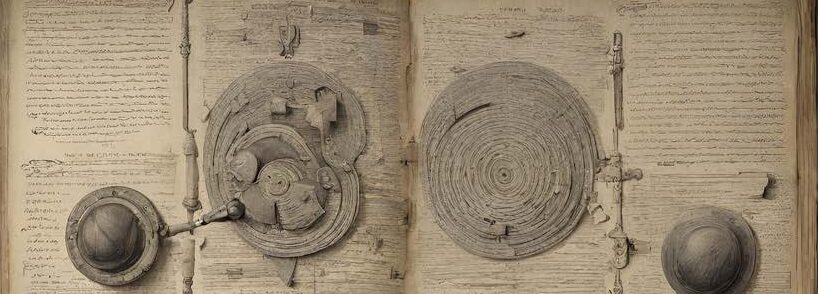
The papyrus scroll, an ancient text technology, served as one of the earliest platforms for written communication. The method of making papyrus scrolls was developed in Egypt around 3000 BCE and was later adopted by the Greeks and Romans. It was crafted from the pith of the papyrus plant, a reed abundant along the Nile River and throughout the Nile Delta. This exhibit examines the papyrus scroll’s role as a crucial medium for recording significant literary, religious, and administrative texts in the ancient past. Furthermore, it also explores the production process, historical context, and the impact of papyrus on the development of writing and reading practices, shedding light on the technology’s profound influence on the spread of knowledge and culture.

This facsimile painting copies a detail from a scene of men harvesting and working papyrus in the tomb of Puyemre.
Historical Background
The invention of papyrus scrolls can be traced back to the banks of the Nile in Ancient Egypt around 3000 BCE. Firstly, this innovation was a beacon of intellectual advancement, not just in Egypt but also as it spread to the Greek and Roman world. The scrolls became crucial in academic, religious, and administrative record-keeping. Their development resulted in a new era of literacy and learning, allowing for a broader spread of information that greatly differed and surpassed oral traditions/communication. Furthermore, as the dominant medium for texts, they played a crucial role in shaping the cultures and literatures of ancient societies, with their influence echoing through the halls of the great Library of Alexandria.

The Nile Delta, seen here, was the prime region for cultivating the papyrus plant, essential for the production of ancient Egypt’s writing scrolls.
The Process Of Papyrus Creation
The artistry behind papyrus scrolls begins with the papyrus plant, Cyperus papyrus, which flourished along the Nile Delta. Harvested for its thick, fibrous stalks, the outer rind was stripped, and the inner pith cut into long, thin strips. These strips were then laid out side by side and overlapped, a second layer placed at a right angle, and the whole assembly was moistened with water and pressed. The natural sap of the pith served as an adhesive, binding the layers upon drying. Additionally, the resulting sheets were hammered to an even thickness all along, polished to a smooth finish for writing, and then joined end to end, creating scrolls that could extend up to 30 feet in length. This meticulous process underscores the value of written text in ancient times—a medium that was both a technological marvel and a work of art, as the production was very difficult and demanding.

These are a group of Papyrus plants near Syracuse, Sicily.
Functions And Form
Papyrus scrolls functioned as the primary material for writing for over three millennia. The unique form of papyrus scrolls, long continuous sheets wrapped around a stick, was well-suited for recording extensive texts, from Homer’s Iliad to religious manuscripts like the New Testament. However, the durability of papyrus was less than ideal. Its susceptibility to moisture and decay means that the surviving scrolls today represent merely a fraction of the ancient knowledge once held in these vast repositories. This can be seen in the image below.

This papyrus scroll is a scholia from Homer’s Iliad XXI, which refers to a grammatical or explanatory comment made by a scholiast.
Impact On Writing And Reading
The widespread usage of papyrus scrolls in ancient times significantly shaped ancient literacy and bibliology. The papyrus scroll’s most profound impact was revolutionizing the recording and preservation of knowledge from ancient times. Furthermore, the transition from scrolling papyrus to the codex between the first to fourth century CE was revolutionary, stemming from a demand for more practical writing and the durability of written material, such as vellum/parchment, which forever changed the literary world.
Personal Reflection
Reflecting on my experience in a workshop where we crafted paper scrolls using stamps, I gained a profound appreciation for the meticulous craftsmanship involved in creating ancient papyrus scrolls. The challenges I encountered such as ensuring proper kerning, aligning letters accurately, and preventing ink smudges illuminated the skill and attention to detail that ancient scribes must have possessed. Furthermore, this hands-on experience revealed the complexities of making scrolls, especially with papyrus, which is much more delicate and less predictable than the paper we use today. Additionally, this experience showed me how much patience, precision, and skill were needed to make these important scrolls in ancient times.
References
Encyclopædia Britannica, inc. (2023, September 21). Papyrus. Encyclopædia Britannica. https://www.britannica.com/topic/papyrus-writing-material
Author. (2016, May 23). Papyrus: A Brief History. Dartmouth Ancient Books Lab. https://sites.dartmouth.edu/ancientbooks/2016/05/23/67/
Stille, A. (2015, October 1). The World’s Oldest Papyrus and What It Can Tell Us About The Great Pyramids. Smithsonian.com.
https://www.smithsonianmag.com/history/ancient-egypt-shipping-mining-farming-econo my-pyramids-180956619/
Capua, R. (2015, March 1). Papyrus-making in Egypt: Essay: The Metropolitan Museum of Art: Heilbrunn timeline of art history. The Met’s Heilbrunn Timeline of Art History. https://www.metmuseum.org/toah/hd/pyma/hd_pyma.htm
Wikimedia Foundation. (2023, November 1). Papyrus. Wikipedia. https://en.wikipedia.org/wiki/Papyrus
Wilkinson, Charles K. and Marsha Hill 1983. Egyptian Wall Paintings: The Metropolitan Museum of Art’s Collection of Facsimiles. New York: The Metropolitan Museum of Art,
p. 7, no. 15 https://www.metmuseum.org/art/collection/search/544592
Wikimedia Foundation (2023, November 1). Papyrus Oxyrhynchus 221. Wikipedia. https://en.wikipedia.org/wiki/Papyrus_Oxyrhynchus_221
Williams, L., Insight Vacations, & Allen, A. (2023, October 9). A long reed: The Page-Turning History of Papyrus in Egypt. Insight Vacations. http://www.insightvacations.com/blog/papyrus-in-egypt/
Wikimedia Foundation (2023, October 18). List Of New Testament papyri. Wikipedia. https://en.wikipedia.org/wiki/List_of_New_Testament_papyri
McGranahan, L. (2018, September 3). A Matter of Life and Death. The University of Chicago Magazine. https://mag.uchicago.edu/arts-humanities/matter-life-and-death
The Editors of Encyclopaedia Britannica (Ed.). (n.d.). Papyrology. Encyclopædia Britannica. https://www.britannica.com/science/papyrology
Wikimedia Foundation. (2004, March 2). Nile Delta. Wikipedia. https://en.wikipedia.org/wiki/Nile_Delta
Author. (2016, May 24). Multi-Quire Codex. Dartmouth Ancient Books Lab. https://sites.dartmouth.edu/ancientbooks/2016/05/24/multi-quire-codex/
